|
|
|
McChina, continued
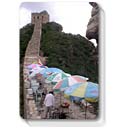 | Click to Enlarge. |
This scenario of the industrious entrepreneur was repeated wherever we traveled. In China, like in much of Asia, the small, family-run business is supreme. There is a unification of living and working space. For the shopkeeper who runs a dry goods store out of her home, she need only walk down a flight of stairs to open her doors for business. Whether it's a small café on top of the Great Wall, or a little watch fixing shop in front door way to a house, the Chinese are establishing businesses every where. Almost every street you walk down, you're likely to find at least one person's small enterprise.
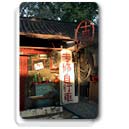 | Click to Enlarge. |
Of course, with this newfound economic vitality comes individuals with newfound wealth. From the Lexus', BMW's, and occasional Cadillacs we saw cruising around the hutongs, these new entrepreneurs are not afraid to flaunt it. Hutongs are the small residential alleyways that are usually lined with ancient, low homes tightly packed together. And, for those Chinese who are tired of living in the same daily, traditional crush of hutongs and humanity, there are now numerous "ideal" communities popping up on the outskirts of Beijing. One ad for a community called Dragon Villas purports that; "Your neighborhood should be the perfect place to play." Well, with rows and rows of identical houses priced over $ 1 million US it had better be perfect. Interspersed with golf courses, social clubs, and swimming pools, in Beijing they called it "a perfect community in an imperfect world." In the States we call it "the Suburbs."
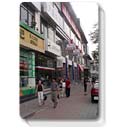 | Click to Enlarge. |
International, western companies have taken notice of the largest consumer base in the world. Kentucky Fried Chicken first opened its doors in China in 1987, and was quickly followed by the likes of McDonalds, Delifrance, and now even Starbucks. So if you visit China, don't worry, you'll have all the comforts of home. Volkeswagon has penetrated the Chinese market to such an extent that, on the highways, you wonder if you haven't been somehow transported to the Autobahn. Of course, with computers and the Internet taking their rightful place in any modernizing society, companies like Intel and Cisco prominently advertise their wares.
 | Click to Enlarge. |
One good way to tell about the economic health of a country is to visit the grocery store. In our case, my mother, a caterer, really wanted to explore one to see what it offered. To all of our surprise, it resembled in many ways a suburban Safeway at home. In fact, most of the companies and products we all know and have grown up with – Coke, Nabisco, Tang, Jiffy, Nestle – were represented here in force. However, it was not a mindless blitzing of the Chinese market with products tailored to Western tastes. Many of the companies seemed to have realized the power behind the Chinese consumer market. They have begun to adapt their products appropriately. For example, you're not likely to find "Wild Consommé" Pringles at home, nor lychee–flavored Nestle powered milk. The occasional "American" taste is presented for the curious, though. You could, for a short time, purchase a package of Oreos bundled with a Coke for that quintessential American sugar high.
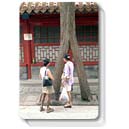 | Click to Enlarge. |
Gone are those drab, uniform Mao worker's suits. Professional men and women can be seen at small street food stalls dressed in the latest fashions from Paris and New York. A crowd of teenagers resembles their counterparts in LA. Boys walk around in their baggy jeans and sports shirts with back-turned caps, and girls stumble around in mini-skirts and the Asian requisite fashion of 6-inch soled shoes. Doctors all over Asia have made a desperate plea to ask women to stop wearing platforms, but to no avail. You can't stop fashion with practical messages.
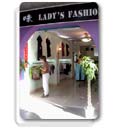 | Click to Enlarge. |
And of course, what would fashion be without the cell phone. How can you really look your best if you're not accessible? On any given evening, at any given restaurant in Beijing – or for that part, Xi'an, Datong, Shanghai, or Kunming – you'll find at least 3 out of 5 people at the table talking on their cell phones, heads shifted just slightly to the perimeter. Cell phones are necessary accessories, and the range of styles reflects that. I'm sad to say that the cell phones in China are much cooler than in the US. Super slim techno–styled, electric blue bubblegum–colored, tiny folding pocket–sized. Whatever fits your style. Gadget envy? Perhaps.
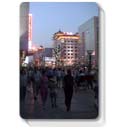 | Click to Enlarge. |
If you walk down Chang An Jie, the large boulevard that cuts between the bottom of the Forbidden City and the top of Tianamen, you come to Wangfujing Dajie. As you turn up Wangfujing, you suddenly encounter a surge of people. Looking up the street, either side is lined with brand new, Western–style shopping malls and stores. If it wasn't for all the Chinese characters on the neon signs, you might think you were on a shopping street in Chicago or Washington, DC. Mary, who had visited Beijing 5 years ago, was in a state of shock. When she walked up Wangfujing Dajie last, it was an eclectic collection of shops and low slung buildings. Today, throngs of Chinese flow up and down the street. Some are there to just gaze up at the towering mesh of modern architecture with traditional details, but most are there to shop! Watch out world, China is here and they're ready to spend!
WSW
|
